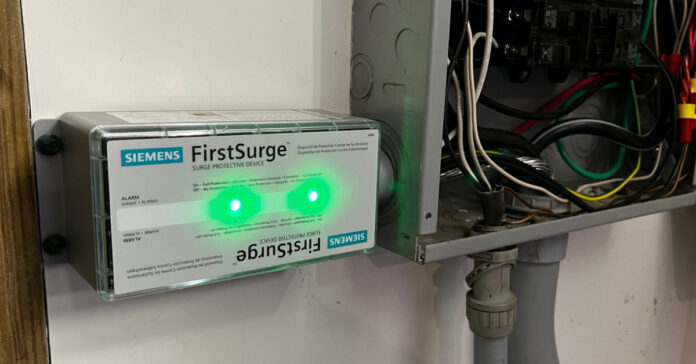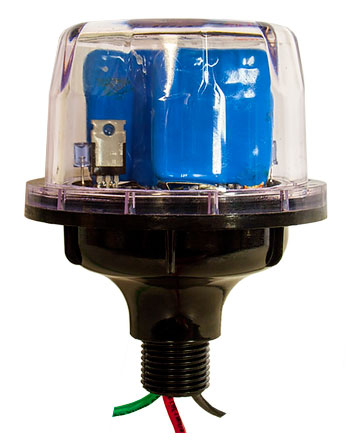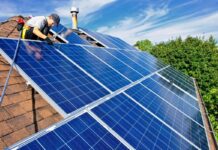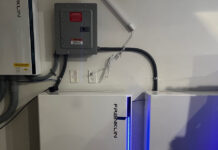
Despite the snow, our licensed electrician/solar power guy made it up here and spent several hours working on our solar power system. Luckily, it got warmer and warmer throughout the day. He quickly accomplished two things and then we spent several hours working on the third.
Surge Protection
The first improvement was the installation of a Siemens FirstSurge whole-house surge protector, which you can see in the image above. While not called for when our house was built, I understand the 2023 national electrical code requires a whole-house surge protector such as this. After our HVAC and oven experienced a blowout because of a surge during our initial solar power installation and testing, we decided to add the Siemens device, which cost me $160, rather than replacing another oven or other appliance.
Our utility provides a surge protection device for a monthly fee, but it is on the meter. A surge coming from the solar system or the generator won’t be intercepted by their surge protector. We are going to cancel the one from our utility, which will save us a few bucks a month.
This device is rated for a surge of up to 100,000 amps, which is a lot of power. They are sacrificial, meaning if they intercept a surge, they get burned out and stop working. That’s what the two green lights seen in the image are for. If the lights go off, you need to replace the device.
The device was easy to install, and I could have done it myself.
Lightning Protection

While the Siemens device is designed for the AC side of the solar system, I purchased a Midnite Solar Lightning and Surge Arrestor rated for 600 volts for the DC side of the system. This was installed outside where the DC current from the solar panels enters the inverter and is converted to AC power. If a lightning strike on or near the house sends a blast of power surging down the cable from the solar panels to the inverter, this device should intercept the surge and shunt it to the ground. It is rated for 115,000 amps, more than the typical bolt of lightning, which the National Weather Service says is 30,000 amps. (They can be higher.)
These devices have an MSRP of $135, and I got mine for just under $100. Again, a small price to pay to protect an inverter that costs thousands.
In an earlier post, I had mistakenly said I was installing EMP protection. I had considered doing so but after doing some research, I decided that the EMP product sounded a bit too good to be true and settled for this device, which I felt was more proven. Will it work on an EMP, too? I don’t know, because no one knows what size, power, or form an EMP strike will take or what distance it comes from. Also, I’m thinking lighting is more likely. In our last house, a nearby lighting strike blew out the circuit board in our gate opener and fried the power supply on the kid’s X-box.
Generator Hookup
After installing these devices, we set up the new generator and tested it out. It successfully connected to the solar power system and ran for eight minutes before it shut down. We then called the Franklin technical support line. Not only are they staffed on weekends, but the individual on the other end was both knowledgeable and quite helpful. We spent about two hours on the phone, trying different settings, sending photos back and forth, and testing different configurations. Finally, at about 4 p.m., we gave up.
The good news is that no appliances or other electrical devices were damaged, the lights didn’t waver and blink on and off, and the rest of the solar power system continues to work just fine. The bad news is I just spend $1,100 on a new generator we can’t hook it up to the system.
Franklin’s tech support rep thinks there may be a faulty CT or generator module inside the Franklin aGate that needs to be replaced. He is going to review our test results with the engineers and will get back to us. I do not know who they will send out to replace the module, if necessary, but I am under warranty, so I don’t expect I will have to pay for it.
Starlink Update
Our local internet service provider still has not completed repairs in our neighborhood. We know folks two miles away that have it up and running, but we don’t. As a result, we continue to operate on Starlink. We’ve had Starlink for about six weeks now, so here are my thoughts on it.
Having Starlink has been wonderful because it gives us connectivity in a self-contained package. For someone in the middle of nowhere, like us, it is great. Without it, we would have no internet, no TV/streaming, and no phone. We’d still be running down the road every day or two to get cell service so we can pick up messages, read our email, and make phone calls.
While Starlink is great, it is not perfect. We get some buffering on video and some dropped calls. This may be because our equipment is on the ground and we do not get a perfectly clear picture of the sky. As a result, we have obstacles which degrade the connection. Mounting Starlink on the roof may eliminate these problems, but we still consider this a temporary installation, so we have not spent the money to purchase a longer cable and a mount and install it on the roof.
The Starlink antenna has a snowmelt function built in so that when it snows, the device warms up and melts off the snow. In our recent snowfall, I found the snow melted off the middle of the antenna but then refroze along the edges. As the ice buildup grew in size, the reception deteriorated. I ended up going out there and scraping the snow and ice off with an ice scraper from the car, something I could not do if the antenna was mounted on the roof.
Starlink versus Fiber Optic
When it worked, our old fiber optic connection was not only faster, it had fewer hiccups, dropped calls and no buffering. With our new mesh routers, which we are using with the Starlink as well, we had speedy internet in all parts of the house, even though we usually have more than a dozen devices connected. The problem with the fiber optic is it goes out when the electrical grid goes out. Last week, when the power went out for a couple hours and our solar power system battery kicked in to run the house, my wife said, “It’s nice to have solar when the grid is down.” She was right. Not only is it nice to stay online, we can receive emails from the utility that tell us when they expect to have it repaired.
Another benefit is I can use the apps for our solar system so we can monitor our battery state of charge. This is a plus in Starlink’s favor.
Our intent had been to go back to the fiber optic when or if they get back up and running. We save $52 a month with it, call it $600 a year. Is it worth $600 to have internet access during our twice-per-month power outages and slightly degraded service the rest of the year?
In the end, it’s a tough call. We will wait to see how robust and fast the fiber connection is when it is re-installed and then make our decision.






